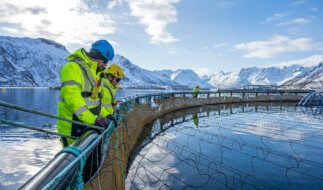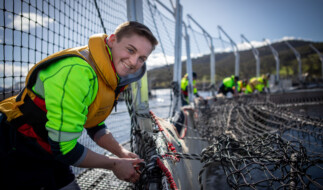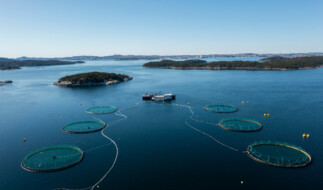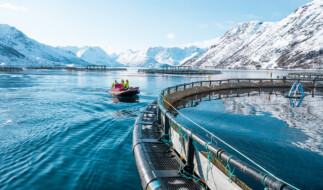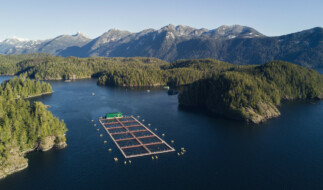Tackling Global Challenges through Innovation

Aquaculture (or fish farming) is one of the most technologically advanced forms of animal protein production, and GSI members are continually looking for ways to innovate operations to farm salmon in even more efficient and environmentally responsible ways.
In this blog, we take a look at some of the ways salmon farming is helping solve some of the world’s most pressing global challenges – from food production to climate change, and share how our unique working model supports faster development and uptake of innovations.
Climate Change – applying the latest innovations to reduce our carbon footprint
When compared to land-based animal farming, salmon farming is a more eco-efficient and climate-friendly protein source for a number of reasons. Farming salmon requires less fresh water, less land and less feed, and as salmon farms are fueled by ocean currents rather than electricity or oil, the draw on energy sources is much lower. This reduced need for resources means that the carbon footprint of farmed salmon is substantially lower than that seen in traditional methods of animal or fish farming. Despite this already lower carbon footprint, salmon farmers continue to look at their operations to further cut emissions.
1. Going carbon neutral
GSI member Camanchaca has set a bold commitment to become carbon neutral by 2025. Implementing strategies to cut emissions such as evaluating clean technologies to replace/complement the use of diesel generators. The company is pioneering the industry’s move to reduce its carbon footprint, and we are sure many others will be inspired to follow in their footsteps. Take a look at Camanchaca’s ambitious carbon reduction milestones below:
Camanchaca’s timeline to carbon neutrality
2018 - Calculation of corporate footprint for Salmones Camanchaca (30,905 tCO2Eq)
2022 - Corporate power contract tendered for 100% renewable energies, offsetting of approximately 14,000 tCO2Eq with forestry project on company-owned land
2023 - Use of diesel in fresh water operations replaced by 100% renewable energies
2025 - Offsetting of remaining emissions with local offset projects
As one of the largest contributors to aquacultures greenhouse gas emissions, the production and distribution of fish feed is one area where improvements to reduce carbon emissions are needed. This is why it is a priority for our feed company associates to find innovative ways to reduce their carbon footprint. Take a look at our recent blog on collaboration to learn more.
2. Introducing renewable energy
Grieg Seafood have become the first salmon farmer to install solar panels and a wind turbine at their Nordeimsøyna farm site. The aim of the project is to substitute the traditional diesel generator with cleaner forms of energy, making it more environmentally-friendly.
“Combining the windmill and the solar panel will make it possible to cut carbon emissions; almost 98 tonnes of CO2 equivalents can be cut per year from this farm only”Ørjan Hadland, team leader at the Nordheimsøy farm
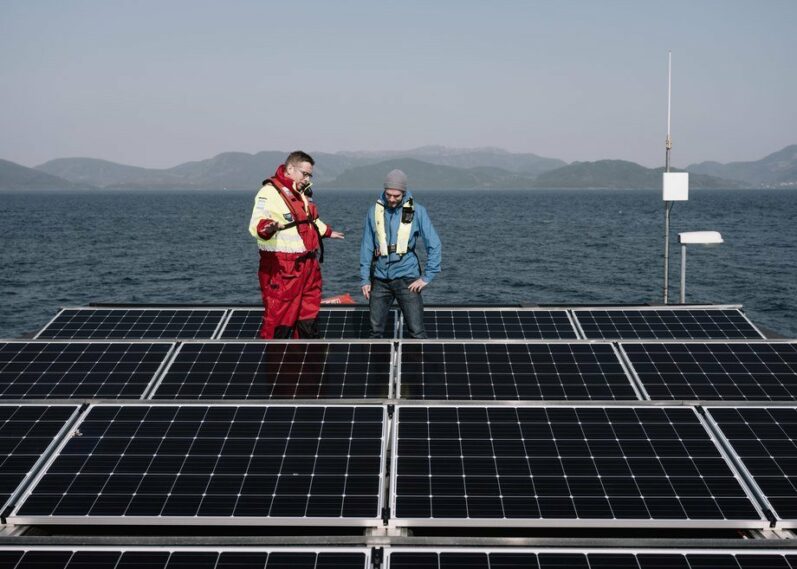
Fish farms can cut CO2 emissions by combining wind and solar power
3. Going circular – turning CO2 into resource
Another example of climate conscious actions comes from GSI associate member Skretting. Skretting have partnered with Kiverdi, an organization that seeks real-world solutions to global resource challenges, to convert CO2 into protein for use in aquaculture feed through bacterial bioprocessing.
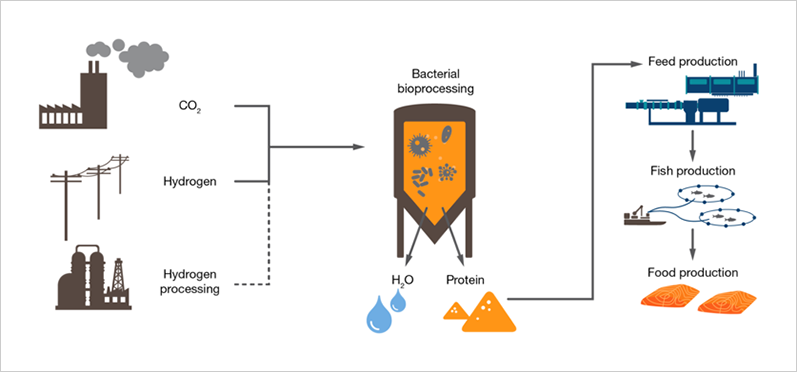
Reference: Skretting: Part V: Transforming recycled CO2
Kiverdi’s approach is based on NASA research that originally aimed to recycle the CO2 produced during space travel. Using a bacterial bioprocessing technique, CO2 is converted into protein and water which are then used as ingredients in feed.
Fish Health and Welfare – incorporating innovation throughout the farming process to farm healthy fish
Good fish health and welfare is a major priority for GSI members. It takes around three years to rear a salmon from egg to harvest, and innovations are incorporated throughout the entire farming fish process to ensure fish are reared with good health and wellbeing in mind. Some of the best-practices used by GSI members to support this are:
- Salmon are reared at low density and take up about 2% of the total farm volume; as the ocean is a three-dimensional space it means that 98% of the salmon pen is made up of water allowing room for salmon to grow, swim around and exhibit their natural behaviors
- Eco-sensitive feed systems; camera and digital sensor systems monitor the fish feeding process and surrounding environment to make sure fish are fed exactly what they need, when they need it
- Supporting R&D: GSI members support ongoing R&D into new fish health technologies and medicines through coordinated trials, expert speaker sessions at biosecurity workshops and transparent reporting of medicinal use for learnings and future improvements
Take a look at Cermaq’s ‘your salmon farmer’ video to learn about the salmon farming process from hatchery to harvest, and the mixture of innovative techniques used along the way to ensure salmon are farmed to the highest welfare standards.
Ocean Health and Biodiversity – supporting healthy ocean ecosystems by reducing pressures on wild fish stocks
As ocean farmers, we understand that the future of salmon farming depends on clean and healthy oceans – where protection and production go hand in hand. The Food and Agriculture Organization (FAO) estimates that close to 90% of wild fish stocks are fished at, or above, sustainable levels. As seafood is the primary source of protein for almost 40% of the global population, we know that something needs to change in order to fulfill the current and increasing demands.
Fish farming provides a method of seafood production that can supply the growing population with healthy protein, alleviating the need to take more wild fish for human consumption.
In an effort to reduce the salmon farming industry’s reliance on wild fish for feed, one of GSI’s priorities is improving the sustainability of our feed ingredients. GSI has made major progress here; in particular accelerating innovation in identifying and developing non-marine omega-3 alternatives. The farmed salmon sector has been supporting R&D into alternative sources of fish feed rich in omega-3 fatty acids, such as algae, plants and even insects!
Algae
Skretting has collaborated with Veramis to incorporate omega-3s from marine algae into fish feed. Algae are the original source of omega-3s in the salmon food chain, and by incorporating the omega-3s straight from the algae into feed, the usual marine food chain is bypassed and the reliance on wild fish is reduced.

Reference: Skretting: Part VI: Omega-3 from marine algae – an innovative solution for increased protein production
Plants
Through recent advances in technology, salmon can be fed a diet high in important omega-3 fatty acids derived from plants. Cargill has combined technology from world-leading chemicals company BASF to provide farmers access to Latitude™, a plant-based fish feed alternative made from canola oil. By replacing fish oil in feed with non-marine alternatives such as canola means that we can meet the market need for long-chain omega-3s while relieving harvesting pressure on wild fish populations.
Hear from GSI members, Grieg and Cargill, as well as friend of the GSI Halley Froehlich discuss the importance of sustainable aquaculture and plant-based sources of omega-3s.
Insects
Black soldier fly: BioMar has been investigating the use of insect meal in replacement to fish meal for a number of years. By utilizing a circular economy approach (harvesting starch and sugars from agriculture to feed black soldier fly larvae). Protein and oil from these larvae are used in aquaculture feed – reducing waste and producing sustainable feed! Ongoing research to find alternative raw materials include mealworms and single-cell protein.
For additional case studies check out our member and associate members websites!
Traceability and ethical supply chains – utilizing modern technology to improve traceability along the salmon farming supply chain
Many of our members are incorporating blockchain and artificial intelligence (AI) technologies to modernize the salmon production processes and improve traceability and transparency across the value chain. By applying blockchain technology to seafood supply chains we can provide a record of where the seafood has come from, how it was produced, what resources went into production and how it reaches people’s plates. This innovation is allowing for more transparency in supply chains and provides traceability on responsible production.
“In 2017, we established our digital transformation program, since then, we have been developing blockchain technology to help boost food safety, sustainability and transparency”Andres Lyon, Multiexport CEO
Learn more about the importance of farmed salmon traceability and its benefits in this video by Mowi:
Why is innovation important to us?
Global food systems are under pressure to produce more while using less, and salmon farming is no exception. While the industry has a good eco-efficient profile, there is always more that can be done to improve. Using GSI as a knowledge-sharing platform, we are focused on finding new and smarter solutions to tackle global sustainability challenges. Innovations can help us become more efficient and reduce our environmental impact with the ultimate goals of supporting a more sustainable future for the salmon farming industry and global future food systems.
